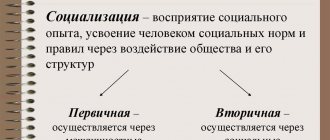When a new personality is born, it receives a unique character as a gift. Human nature can consist of traits inherited from parents, or it can manifest itself in a completely different, unexpected quality.
Nature not only determines behavioral reactions, it specifically influences the manner of communication, attitude towards others and oneself, and towards work. A person's character traits create a certain worldview in an individual.
A person’s behavioral reactions depend on character
What is character?
- Character, personality, personality refers to the sum of characteristics that a person possesses. Character refers primarily to moral qualities, ethical standards, principles and the like; a man of impeccable character.
- Individuality refers to the distinctive qualities that make a person recognizable as an individual different from others; a woman with a strong personality.
- Personality refers to the combination of external and internal characteristics that determine the impression a person makes on others: a child with a bright or pleasant personality.
Tips for describing a character's character
guweiz
Don't reveal your entire character at once
Drastically describing all of your character's characteristics will lead to a lack of engagement in the reader. Reveal his identity so that no one knows everything about him from the very beginning. Don't speak directly, use comparisons, epithets, metaphors. Show other people's discussions to learn something new about the character through their words. Talk about the little details that go along with it. Tell about the actions of the hero, write about goals, thoughts, feelings.
Close to nature
Most writers use landscapes, a character's relationship with nature, to reveal his soul, to open secret doors within his own self. This also includes closeness to the people, to the family, to the social class.
Eyes are the mirror of the soul
A person's eyes can tell a lot about him. If there is no description of the eyes in the story, it means that something is wrong with this character. As if there was nothing inside him, as if he were a machine without any feelings. This point can help well in characterization.
Avoid clichés
A cliché is a template by which this or that thing is most often described. Of course, you can use descriptions like “he had deep blue eyes like the sea” or “her long wavy golden hair blew in the wind.” However, this has all been used so many times that it leaves virtually no impression on the reader.
What kind of character does a person have?
Correct assessment begins with determining what types of character people have. All traits are distributed into five main groups:
Social
It includes traits determined by attitude:
- to yourself;
- labor;
- to society.
Emotional
It includes:
- expressiveness;
- impressionability;
- cheerfulness;
- high and low emotionality;
- impulsiveness;
- impressiveness;
- unstable emotionality.
Strong-willed
It includes:
- focus;
- determination;
- persistence;
- uncertainty;
- courage;
- discipline;
- independence.
Intelligent
It includes:
- prudence;
- depth and flexibility of intelligence;
- resourcefulness;
- mindset (practical or theoretical);
- frivolity;
- intelligence;
- curiosity;
- thoughtfulness.
Moral
It includes the following features:
- rigidity;
- kindness;
- responsiveness;
- honesty and similar qualities.
To compile a psychological portrait, certain qualities are noted.
Essay Characteristics of a Person (Friend)
Every person has a friend. Friends can be close and real. I also have a close friend whose name is Vitya. My friend will soon be 13 years old. We have been friends with him for a long time, and he has never let me down.
Vitya is in 8th grade, just like me. He is very sociable, so it is very easy to talk to him and find a topic for conversation. He very quickly finds topics for conversation and tries in every possible way to prolong it. It is very difficult to stop him in the midst of a conversation, but I did not have to do this, since communicating with him brings benefits and pleasure.
Another trait of his character is responsibility. A responsible approach to business and compliance with the rules is all about him. There were probably no cases that he would have treated irresponsibly.
So his mother will ask him to go to the store for bread and give him money, so he will buy what he needs and not spend the day on something else. Even when we walk in the yard, he always tries not to stay late and advises me to do this.
Vitya is also a very creative person. He has a lot of interesting ideas in his head. While we are walking, he can come up with many different ideas for games. He will gladly help his mother figure out something to do with her little sister.
It’s not for nothing that they say that a friend is a friend in need. This is how my friend will not leave me or his other friends in trouble. He will always come to the rescue. Even in the situation when my cat disappeared, when he learned about it, he came to my house and offered his help. He helped me put up advertisements and look for my cat.
Vitya loves sports very much. Every evening he goes for a long walk with his parents. Then they visit the sports ground. He knows how and loves to jump rope. But he loves to play ball. Together with their parents and neighbors, they built a small football field where children now play.
But along with these traits, he also has some negative ones. One of these is his sloppiness. He always comes home from parties with dirty clothes. But maybe football players can’t do otherwise and in the future he will become a real football player?
Thus, my friend Vitya has many good qualities. What I like about him is his responsibility and the fact that he won’t leave me in trouble. Here I can say with confidence that Vitya is my best friend.
What are the character traits of a person?
The positive ones include:
- adequacy, altruism, activity;
- fearlessness, frugality, prudence, nobility;
- generosity, good manners, politeness, attentiveness, cheerful disposition, will, high morality;
- humanism, gallantry, harmony;
- friendliness, delicacy, conscientiousness, discipline, foresight, diplomacy, efficiency, kindness, good nature;
- naturalness;
- femininity, cheerfulness;
- caring, thrifty;
- ingenuity, initiative, diligence, sincerity, intelligence;
- creativity, sociability, correctness, culture, competence, collectivism, eloquence;
- curiosity, affection, ease of communication;
- wisdom, masculinity, peacefulness, dreaminess;
- tenderness, independence, reliability, observation, resourcefulness;
- experience, sociability, charm, education, caution, responsibility, neatness, responsiveness, talent, objectivity;
- decency, positivity, practicality, understanding, friendliness;
- decisiveness, romance, cordiality;
- self-criticism, modesty, intelligence, conscientiousness, independence;
- tactfulness, hard work, desire for creativity, patience;
- smiling, perseverance, poise, respectfulness, perseverance, courtesy, perseverance;
- thriftiness, charisma, courage;
- chastity, determination;
- sincerity, honesty, sensitivity;
- generosity, playfulness;
- energy, economy, enthusiasm, empathy, erudition.
Negative qualities include all the antipodes of the listed traits.
For example:
- aggressiveness;
- vulgarity;
- impudence;
- envy;
- arrogance;
- deceit;
- commercialism;
- narcissism;
- touchiness;
- selfishness;
- callousness, etc.
Every positive trait has an opposite meaning. However, there are some qualities that can be called neutral:
- shyness;
- silence;
- assertiveness;
- shyness;
- daydreaming.
For some people these are positive qualities, for others they may be negative. For example, assertiveness. In business it is sometimes necessary, but in personal relationships it sometimes gets in the way. Shyness is good for a girl, but is perceived negatively when it appears in a young man. When drawing up a psychological portrait, all of the above positive qualities, their antipodes and other features are taken into account.
Adjectives to describe a person's appearance
When meeting someone, the first thing a person does is subconsciously evaluate their appearance and select the appropriate words. The following vocabulary is used for this:
- attractive, charming, stylish, elegant, beautiful, impressive - to describe the image as a whole;
- tall, short, slender, thin, plump, fat, well-fed, pumped up, thin - help characterize the physique;
- young, adult, young, old, elderly - characteristics of age;
- long-haired, curly, wavy, bald, cropped, as well as names of colors (red, black, dark chestnut) are popular adjectives to describe hairstyles;
- chubby, freckled, high-cheeked, big-eyed, large-mouthed, light-skinned, snub-nosed - these and other words help describe facial features.
Manifestation of character and temperament
A person’s character is not formed instantly, but until old age. The social environment is of great importance. For example, the volitional qualities inherent in a person manifest themselves in emergency situations when endurance, courage, stubbornness, etc. are required.
Emotionality is mental manifestations that arise in certain situations. In this case, feelings can be negative or positive, dynamic or stable, neutral. If we talk about intelligence, then this includes the individual characteristics and quality of thinking of an individual. For example, criticality, stupidity, breadth of soul, flexibility in any relationship, etc.
The character of people greatly influences their perception of the environment. Some consider everyone good or bad, others only themselves. Each person has a certain attitude:
- to oneself (self-esteem, self-criticism, self-respect, etc.);
- labor (punctuality, accuracy, negligence, etc.);
- environment (politeness, isolation, sociability, rudeness, etc.).
As a result, a certain temperament is formed. It includes qualities that are constant for a particular person:
1. Sanguine people are very mobile and efficient, but they quickly get tired of hard work. They have bright facial expressions and strong expressions of emotions. They are sociable, responsive, balanced. They look at everything from a positive point of view and are optimistic. They have a cheerful disposition.
2. Cholerics are characterized by sudden mood swings, hysteria, and impetuosity. They have frequent outbursts of anger, short temper, but quick release.
3. Melancholic people are pessimists, they worry excessively about any reason, and are often in an anxious state. Such people are very distrustful of others, vulnerable, reserved, and have good self-control.
4. Phlegmatic people have very low activity. However, they are very reasonable, cold-blooded and prudent. Any task is always completed.
Separately, it is worth noting that each nationality has its own character traits, although there are many common features. The greatest diversity is among the Russians.
Their character is very different from other nationalities.
Main criteria:
a) Spiritual generosity, which most nationalities do not have. b) Compassion.
c) Craving for justice.
d) Patience, endurance, perseverance.
e) Negative qualities include pessimism, foul language, laziness, hypocrisy. The positive ones are responsiveness, loyalty, compassion, humanity.
Russians are easily distinguished by a combination of character traits, one of which is a special sense of humor, which other nationalities are not always able to understand. The set of qualities is so diverse that most people experience excessive expression of emotions. Some traits may change throughout life. However, other qualities remain unchanged. However, negative traits are not always regarded as negative. Sometimes they emphasize dignity.
For example:
1. Selfishness is not only ignoring other people, but also putting one's own interests first. Such a person has his own opinion and will not follow the lead of others.
2. Self-confidence can improve productivity and performance. Then the person feels self-satisfied, which ultimately brings positive results for society.
3. Envy sometimes pushes a person to work better and achieve the best result.
4. Stubbornness helps you achieve any goals you set.
The character of any person consists of positive and negative qualities. As a result, a certain type is formed. For example, a person can be lazy, but kind and sympathetic. The other is angry, but very hardworking and aspiring. At the same time, women are always more emotional, selfless, good-natured, and patient. Men are most often reserved, decisive, and responsible.
List of personality traits
Human nature is a complex combination of unique traits that forms a unique system . This order includes the most striking, stable personal qualities, revealed in gradations of human-society relationships:
| Relationship system | Inherent Traits of an Individual | |
| Pros | Cons | |
| To self | Pickiness | Condescension |
| Self-criticism | Narcissism | |
| Meekness | Boastfulness | |
| Altruism | Egocentrism | |
| To the people around you | Sociability | Closedness |
| Complacency | Callousness | |
| Sincerity | Deceit | |
| Justice | Injustice | |
| Community | Individualism | |
| Sensitivity | Callousness | |
| Courtesy | Shamelessness | |
| To work | Organization | Laxity |
| Mandatory | Cluelessness | |
| Performance | Sloppiness | |
| Enterprise | Inertia | |
| Hard work | Laziness | |
| To items | Economy | Wastefulness |
| Thoroughness | Negligence | |
| Neatness | Negligence | |
In addition to the character traits included by psychologists in the gradation of relationships (as a separate category), manifestations of nature in the moral, temperamental, cognitive and sthenic spheres were highlighted:
- moral: humanity, toughness, sincerity, good nature, patriotism, impartiality, responsiveness;
- temperamental: passion, sensuality, romance, liveliness, receptivity; passion, frivolity;
- intellectual (cognitive): analytical, flexible, inquisitive, resourceful, efficient, critical, thoughtful;
- sthenic (volitional): categoricalness, persistence, obstinacy, stubbornness, determination, timidity, courage, independence.
Many leading psychologists are inclined to believe that some personality traits should be divided into two categories:
- Productive (motivational). Such traits push a person to perform certain actions and actions. These are goal-traits.
- Instrumental. Giving personality during any activity individuality and method (manner) of action. These are methods-traits.
Gradation of character traits according to Allport
Allport's theory
The famous American psychologist Gordon Allport, an expert and developer of gradations of an individual's personal characteristics, divided personality traits into three classes:
Dominant . Such traits most clearly reveal the behavioral form: actions, activities of a certain person. These include: kindness, selfishness, greed, secrecy, gentleness, modesty, greed.
Ordinary . They manifest themselves equally in all numerous areas of human life. These are: humanity, honesty, generosity, arrogance, altruism, egocentrism, cordiality, openness.
Minor . These nuances do not have a particular impact on behavioral reactions. These are not dominant behaviors. These include musicality, poetry, diligence, and diligence.
A strong relationship is formed between a person’s existing personality traits. This pattern forms the final character of the individual.
But any existing structure has its own hierarchy. The human warehouse was no exception. This nuance is traced in Allport's proposed gradation structure, where minor traits can be suppressed by dominant ones. But in order to predict an individual’s actions, it is necessary to focus on the entire set of personality traits .
Human character traits (weaknesses and strengths)
| Character Strengths | Character Weaknesses |
| Brave | Reckless |
| Idealistic | Naive |
| Funny | Frivolous |
| Confident | Arrogant |
| Careful | Timid |
| Virtuous | Hard |
| Open-minded | Excessive |
| Definite | Stubborn |
| Loyal | Ostrovny |
| Modest | Passive |
| Patient | Unproductive |
| Vigorous | Exhausting |
| Independent | Outsider |
| Figurative | Unrealistic |
| Charismatic | Self-centered |
| Emotional | Illogical |
| Proud | Conceited |
| Managed | Greedy |
| Logical | Unempathetic |
| Honest | Blunt |
| Decisive | Impulsive |
| A born leader | Imperious |
| Concentrated | Addictive personality |
| Curious | Aimless |
| Kind | Unassuming |
| Principal | Intolerant |
| Charming | False |
| Adaptable | Structureless |
| Realistic | Cynical |
Can you remember what I missed? Leave a comment and I'll add them to the post!
Why is a psychological personality portrait used?
The psychological portrait plays a fundamental role when choosing a future occupation. Before entering an educational institution, you need to find out in which area a person can achieve great success. After all, nothing good will come of doing something you don’t like.
Thanks to a high-quality psychological portrait of a person, interested parties can get to know a person better and understand the motives of his behavior. With the help of such a description, it is possible to identify lies, a tendency to conflict, strong and weak character traits.
Many managers, when hiring for a vacant position, test candidates to determine the qualities and abilities of the applicants. It is important for managers to know how a person will act in a difficult situation, whether he will be able to solve problems, and whether the individual has the character traits necessary to complete the task.
A psychological portrait of a child will help a teacher find an approach to his student. If adults want to reach the hearts of children, they need to know child psychology. Having determined the type of temperament of each child, you can competently plan the process of raising him.
Psychologists, at the client’s request, draw up a psychological portrait of a person in order to find him a suitable life partner. After all, it is known that two polar personalities will not be able to build harmonious relationships. If partners want to avoid conflicts and misunderstandings, they must have similar values, a suitable temperament, think alike and work together towards a cherished goal.
Methodology for compiling psychological characteristics
Psychological characteristics of a person are compiled by psychologists using the following methods:
- Observation. Through specially organized observation, the psychologist receives information about the characteristics of an individual’s behavior. In psychological characteristics, observation results indirectly reflect personality characteristics.
- Psychodiagnostic methods. Using personality tests and questionnaires, the psychologist determines the client’s temperament type, his interests and inclinations, and the prevailing motives for his activity. This information is the main one in the psychological characteristics.
- Sociometry. With the help of this diagnostic tool, the psychologist receives information about the socio-psychological status of the individual in the educational or work community. Sociometry allows us to identify the characteristics of a person’s interpersonal interaction with friends and colleagues.
- Interview. If sufficient information about a person cannot be obtained through tests, the psychologist develops a series of questions that he asks the client. This method of collecting information is used to clarify facts and eliminate contradictions.
Psychological characteristics begin with the listing of a person’s personal data: indicating the last name, first name and patronymic, date of birth, place of residence, reporting information about family members and characteristics of family upbringing. The following are described:
- inclinations and interests;
- personality abilities;
- characteristics of temperament and character;
- a person's attitude towards himself;
- a person's attitude towards other people;
- a person's attitude towards work.
An example of a person's psychological characteristics
Letovaltsev Andrey Yurievich
Date 04/19/2008.
Mother: Letovaltseva Anna Gennadievna.
Father: Letovaltsev Yuri Alekseevich.
Place of residence: Novodvinsk
The child is raised in a complete family. Parents take an active part in the boy's life. For Andrey, his older brother is a role model.
The boy shows interest in exact sciences and has a high level of development of logical thinking. For two years, Andrey has been attending robotics courses and participating in city and regional competitions.
The boy's level of voluntary attention is above average. There are no signs of fatigue when performing work. The pace of work is high.
The boy has a high level of visual memory development. Auditory memory is moderately developed. The dominant channel for obtaining information is visual.
The predominant motive for activity is to avoid failure. The level of anxiety corresponds to the age norm.
In the course of solving intellectual problems, Andrey demonstrates independence and rationality. Willingly comes to the aid of his comrades. Shows interest in pair work. When working in a group, he imposes his opinion on his comrades and makes many comments. He takes criticism addressed to him painfully.
In a group of peers, the boy strives to become a leader. He is ambitious and active. Andrey tries to assert himself at the expense of other children. However, in order to become a leader, the boy lacks sensitivity and attentiveness to others. In addition, the boy has high self-esteem.
Andrey has a choleric type of temperament. The young man is emotional, assertive, and purposeful. He often has conflicts in his relationships with peers. Poor development of communication skills does not allow making concessions and finding a compromise solution to controversial situations. The boy is characterized by sudden mood changes.
There are outbreaks of aggression in behavior. It is difficult for a boy to control his emotional reactions.
Based on the results of psychological diagnostics, Andrey can be recommended a course of individual sessions with a psychologist aimed at correcting the emotional-volitional sphere. The boy will also benefit from group classes in the form of training to develop communication skills.
What is it for?
Everyone can try to make their own psycho-portrait or study the behavior of a loved one. However, to obtain accurate and most reliable data, it is better to seek help from a specialist. To fully determine your personality characteristics, sign up for my personal consultation. Having such data, you can find the most suitable occupation, hobby, find out the degree of your openness and sociability, identify goals, and increase self-esteem.
An example of writing a psychological portrait of a personality
Only an experienced psychologist can draw up a psychological portrait of any personality. The specialist selects a testing technique that corresponds to the purpose of a particular study. In order to analyze yourself yourself, you should use simplified methods, for example, testing DISC personality typology or socionics. Similar tests can be easily found on the Internet and taken online. With their help you can find out your character type.
An example of a psychological portrait of a personality based on questionnaires by Cattell, Mehrabian, and Eysenck:
- Nikiforova Elena, 20 years old, student;
- character traits: sociable, has many friends, good-natured, emotional, often acts under the influence of emotions, impulsive, prone to aggression;
- temperament: according to the Eysenck questionnaire, sanguine, easy to meet and communicate, adapts well to unusual living conditions;
- intelligence: according to the results of the Cattell questionnaire, intelligence is above average, has abstract thinking, excellent intelligence, quickly perceives new information;
- motivation: according to the questionnaire, Mehrabian is motivated to achieve her goal, that is, success;
- emotional stability: average, easily excited, too emotional, unyielding, irritable;
- communication skills: talkative, active, often distrustful, prone to leadership, independent, knows how to behave in a new team;
- summing up: the test results are within the normal range, attention should be paid to the excessive suspicion and inflexibility of the subject being studied.








